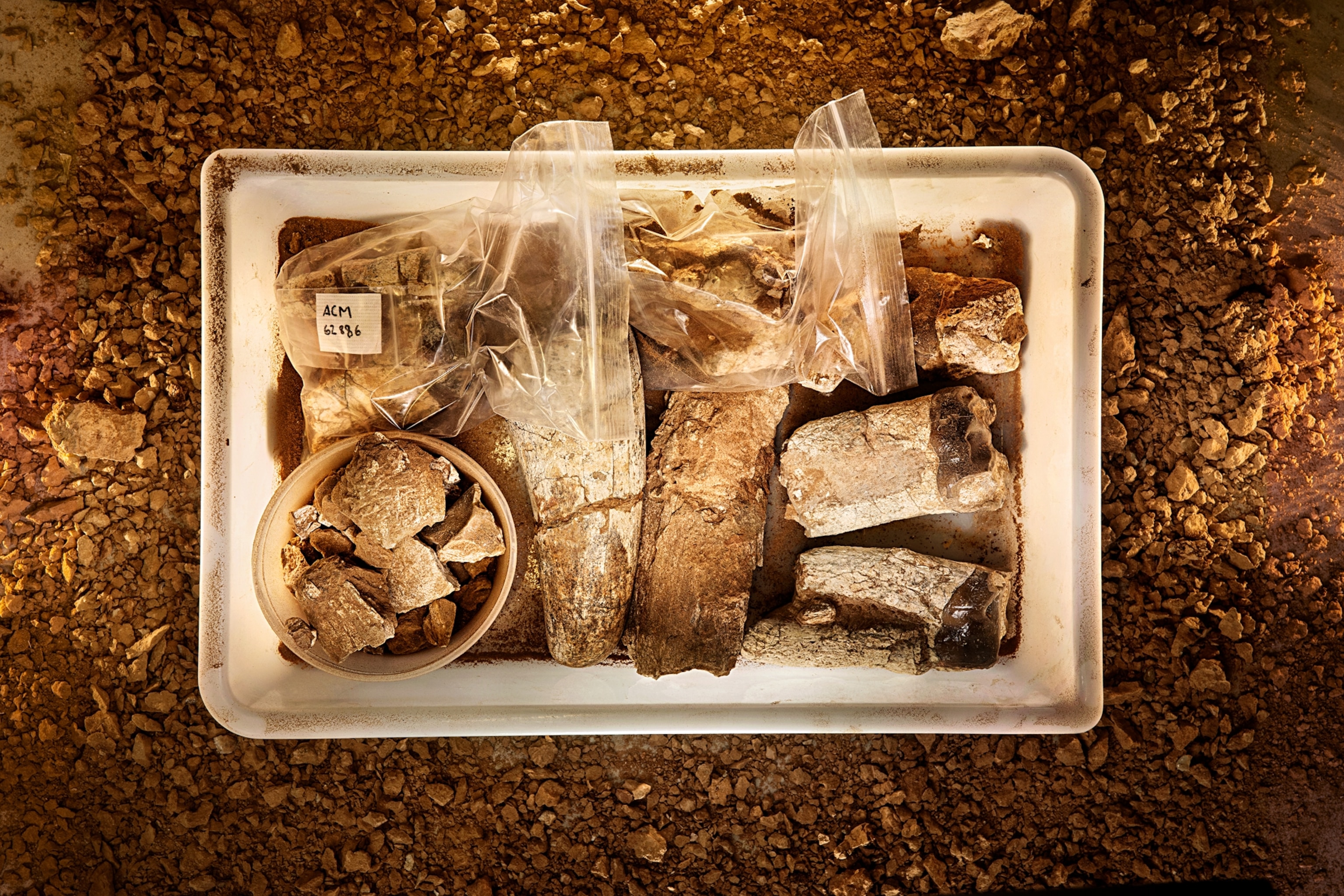
See the fabulous fossils unearthed in a garbage dump
As a landfill expands in Spain, paleontologists are uncovering many ancient species, including some that were the precursors to apes—and us.
Fewer places are less welcoming than a garbage dump on a frigid night.
But that’s where paleontologist Josep Robles found himself in December 2019, on the hunt for rare clues to human evolutionary history.
For much of the past couple of months, he’d spent several nights a week at the Abocador de Can Mata, the largest active landfill in the Catalonia region of Spain. Seven days a week, 24 hours a day, excavators had been plunging their metal claws into the earth in a rush to create yet another deep pit to hold trash from Barcelona and its surroundings. Robles was one of eight paleontologists on rotation to keep a close eye on the rocky tons of tawny dirt displaced by the diggers.

During the day, the sickly sweet aroma of rot drew squawking flocks of gulls; the dirt, as soft and fine as powdered sugar, rose in small clouds with Robles’s every step. At night he dressed in heavy layers, a headlamp strapped to his hard hat. Whenever he spotted a mass that seemed to have potential, he waved to the excavator operator to pause while he investigated the object more closely.
If it still looked promising, he covered it with light-catching silver foil for removal in the morning, by light of day. Then he’d back away, give the all clear, and the roar of the machine would begin once again.
The soil of Can Mata holds a wide array of fossils spanning more than a million years in the Miocene, from about 11.2 million to 12.5 million years ago. Since 2002, Robles and other paleontologists from the Catalan Institute of Paleontology Miquel Crusafont (ICP), at the Autonomous University of Barcelona, have found more than 70,000 fossils from this period. They include those of horses, rhinoceroses, deer, elephant relatives called proboscideans, an early kin to the giant panda, and the world’s oldest flying squirrel. There’s also a wealth of ancient remains from rodents, birds, amphibians, and reptiles.
But among the most important discoveries are fossils of primate species found nowhere else. Many are broadly ancestral hominoids—the precursors to gibbons; to great apes, including orangutans, gorillas, and chimpanzees; and to us. During the middle Miocene, there were dozens of hominoid species. They had originated in Africa, but by 12.5 million years ago, they’d also appeared in Asia and Europe. The primate bones found at Can Mata are helping to fill in the picture of a period deep in our past that, in many ways, remains murky.
“Can Mata has enabled us to show that primates were much more diverse in that time span than considered before,” says ICP director David Alba.
And each new fossil clue helps us unravel some of the most profound mysteries of our species: What are we? Where did we come from? And when did we begin to be?

Located about 30 miles northwest of Barcelona, Can Mata landed on the primate fossil map in the early 1940s when Miquel Crusafont, namesake of the ICP, discovered the partial mandible and teeth of a Miocene great ape at the site. Subsequent finds helped establish Can Mata as a documented paleontological site. Despite its status, it also has operated legally as a landfill since the mid-1980s.
In the early 2000s, when site operator Cespa Waste Management wanted to dig new trash-holding cells at least 100 feet deep, the company was obliged under the Spanish Historical Heritage Law to make sure its machines weren’t crunching through fossils or burying them beneath mounds of trash. Cespa approached some fossil-spotting scientists to supervise the excavations, and they jumped at the chance to access the dump’s depths.
Each new fossil clue helps us unravel some of the profound mysteries of our species: What are we? Where did we come from? And when did we begin to be?
In 2002, freelance paleontologists (now all with the ICP) Isaac Casanovas-Vilar, Jordi Galindo, and Alba—who was then a Ph.D. student—began monitoring the dig at Can Mata. Three weeks into the work, they unearthed the tooth of a dinothere, an enormous elephant relative with downward-curving tusks. Investigating the spot more closely, they found a fragment of a finger bone. “I was like, man, this looks like a primate,” recalls Alba.
He ran to his car and retrieved a cast of the hand of the extinct ape Hispanopithecus, which had been discovered in a nearby valley. The paleontologists compared the two but were still unsure what they’d found. Next they found three fragments of a canine tooth, which Alba glued together, and a cache of tiny, fragile bone fragments scattered near a block of sediment. Camera in hand, Alba lay on his stomach to get a better look at the underside of the block.
He was shocked to realize he was eye to eye with an ancient face. “The three of us, very nervous—we were barely speaking—turned it up,” he says. “And there was the face of Pierolapithecus looking up at us. So it was one of the biggest moments in my life.”
Pierolapithecus catalaunicus, nicknamed Pau, is what they’d eventually call the new species of great ape they’d discovered. About 12 million years old, it’s one of the most complete Miocene primate skeletons ever found. The team went on to unearth additional bones from the animal’s chest, lower back, and wrists. It’s the oldest known primate fossil to show unambiguous evidence of a characteristic unique among apes and humans: an orthograde—or upright—body plan.
“This is not to be confused with biped,” Alba notes. “Some people use upright to mean biped. This is plain wrong.”
Instead, the orthograde body plan enables vertical climbing, suspending from branches, swinging from tree to tree, and sometimes walking on two feet. While some of these behaviors likely evolved several times independently, the orthograde body plan might have evolved only once, or perhaps twice. According to Alba and his colleagues, the Pau fossil suggests the last common ancestor of all hominids might have been orthograde. If so, that may offer a hint at what gave certain species an evolutionary edge.



The team at Can Mata also was thrilled to find another new hominoid called Anoiapithecus brevirostris, dating to roughly 12 million years ago. Most primate faces protrude, but the face of this fossilized male, nicknamed Lluc, was intriguingly flat—so much so that it seems reminiscent of faces in our own genus, Homo. The researchers proposed that this was the result of convergent evolution, in which similar characteristics evolve in unrelated or distantly related organisms.
Then in 2011 came the fossil of a female Pliobates cataloniae, nicknamed Laia. This newfound species lived about 11.6 million years ago—about half a million years later than Pau. She was tiny, weighing about the same as a house cat, but paleontologists were surprised to find that she had a few ape features, such as her gibbon-like wrist bones and skull shape.
Understanding the roots of great apes is important for figuring out the origins of hominins, the taxa that arose after our lineage and chimpanzees’ split from their common ancestor six million to eight million years ago. The human lineage “did not appear out of nowhere,” Alba says. “So we need to know where they did evolve from.”

The fossil gold mine in the garbage dump has yielded more than 85 mammal species that lived alongside these prehistoric primates.
One recent find is a Chalicotherium, a tall, clawed ungulate that looks like a bizarre mix of giant sloth, bear, horse, and gorilla. Another is a false saber-toothed cat, so called because it’s not a true felid, the family that includes lions and tigers. Instead, it belonged to a family of carnivores that diverged from the ancestors of felids perhaps 40 million years ago.
The fossils all date to an important transitional period from the middle to the late Miocene, when the region’s subtropical rainforests were becoming more arid and grasslands expanded. The scientists are using these finds to help reconstruct Can Mata’s environmental changes over about a million years, in time slices of 100,000 years. That resolution is possible because Can Mata has a long, continuous geological record.
“It’s several hundreds of meters of sediments, all with fossils,” says ICP’s Casanovas-Vilar. This work is just beginning, but the researchers hope to illuminate the local impact of global climate change—in both the past and the present.




“Ecosystems can tolerate changes for a time, but for how long? That’s one question that we can answer or that we’ll try to answer for this particular environment and this particular time,” Casanovas-Vilar says.
The big question is whether digging will be possible in the decades to come. Some residents have had it with Can Mata—its ripe stench, its endless procession of exhaust-spewing garbage trucks, its ongoing expansion. In fall 2019, even as Robles and his colleagues monitored the excavators, protesters gathered at the dump entrance holding signs written in Catalan. Prou pudors. Tanquem l’abocador. Volem respirar en pau. “Enough stink.” “Close the landfill.” “We want to breathe in peace.”
Yet in a recent referendum locals approved the dump’s expansion, potentially through the end of the decade. So the scientists won’t leave anytime soon. They also have plenty of work ahead on the fossils they’ve already unearthed. Only 20 percent of their finds have been cleaned of hardened sediment and chemically preserved. Thousands more are cocooned in brown paper and plastic wrap in cool, underground storage rooms. Numbered and labeled, each bundle waits for a curious researcher to unwrap it. Some have been waiting nearly 20 years.
“This is something for the next three or four generations of paleontologists,” Alba says. “I’m sure there are interesting fossils hiding here.”

Journalist Jennifer Pinkowski is a New Yorker based in Berlin covering science and history. Photographer Paolo Verzone previously focused on dinosaur fossils, in the October 2020 issue.
This story appears in the July 2021 issue of National Geographic magazine.
Related Topics
You May Also Like
Go Further
Animals
- Octopuses have a lot of secrets. Can you guess 8 of them?
- Animals
- Feature
Octopuses have a lot of secrets. Can you guess 8 of them? - This biologist and her rescue dog help protect bears in the AndesThis biologist and her rescue dog help protect bears in the Andes
- An octopus invited this writer into her tank—and her secret worldAn octopus invited this writer into her tank—and her secret world
- Peace-loving bonobos are more aggressive than we thoughtPeace-loving bonobos are more aggressive than we thought
Environment
- This ancient society tried to stop El Niño—with child sacrificeThis ancient society tried to stop El Niño—with child sacrifice
- U.S. plans to clean its drinking water. What does that mean?U.S. plans to clean its drinking water. What does that mean?
- Food systems: supporting the triangle of food security, Video Story
- Paid Content
Food systems: supporting the triangle of food security - Will we ever solve the mystery of the Mima mounds?Will we ever solve the mystery of the Mima mounds?
- Are synthetic diamonds really better for the planet?Are synthetic diamonds really better for the planet?
- This year's cherry blossom peak bloom was a warning signThis year's cherry blossom peak bloom was a warning sign
History & Culture
- Strange clues in a Maya temple reveal a fiery political dramaStrange clues in a Maya temple reveal a fiery political drama
- How technology is revealing secrets in these ancient scrollsHow technology is revealing secrets in these ancient scrolls
- Pilgrimages aren’t just spiritual anymore. They’re a workout.Pilgrimages aren’t just spiritual anymore. They’re a workout.
- This ancient society tried to stop El Niño—with child sacrificeThis ancient society tried to stop El Niño—with child sacrifice
- This ancient cure was just revived in a lab. Does it work?This ancient cure was just revived in a lab. Does it work?
- See how ancient Indigenous artists left their markSee how ancient Indigenous artists left their mark
Science
- Jupiter’s volcanic moon Io has been erupting for billions of yearsJupiter’s volcanic moon Io has been erupting for billions of years
- This 80-foot-long sea monster was the killer whale of its timeThis 80-foot-long sea monster was the killer whale of its time
- Every 80 years, this star appears in the sky—and it’s almost timeEvery 80 years, this star appears in the sky—and it’s almost time
- How do you create your own ‘Blue Zone’? Here are 6 tipsHow do you create your own ‘Blue Zone’? Here are 6 tips
- Why outdoor adventure is important for women as they ageWhy outdoor adventure is important for women as they age
Travel
- This royal city lies in the shadow of Kuala LumpurThis royal city lies in the shadow of Kuala Lumpur
- This author tells the story of crypto-trading Mongolian nomadsThis author tells the story of crypto-trading Mongolian nomads
- Slow-roasted meats and fluffy dumplings in the Czech capitalSlow-roasted meats and fluffy dumplings in the Czech capital

_square.jpg)





